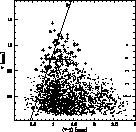In the color magnitude diagram (Fig. 8) all galaxies brighter than
V = 23.5 mag are shown. Most of the objects have colors of about (V-I) =
1.2 mag similar to the average color of the GCSs of the
ellipticals in Fornax (Kissler-Patig et al. 1997).
Assuming ![]() mag towards Fornax, all galaxies
redder than V-I = 1.8 mag are most likely background galaxies (since no
redder stellar populations are expected from any theoretical stellar evolution
model, e.g. Worthey 1994).
The definite cluster dwarf galaxies (circles) are located at the blue side
of the color distribution. Since most of them are early-type dwarfs and show
no indications of star formation, their blue colors can only be explained
by low metallicities.
The dEs and dE, Ns follow a sequence in the sense that fainter galaxies are
bluer (see dashed line in Fig. 8). This trend was already
noticed by Caldwell & Bothun (1987, who
measured UBV magnitudes of 30 relatively bright Fornax cluster dwarf
ellipticals) and continues for dwarfs with low surface brightness
(Bothun et al. 1991; Cellone
et al. 1994). Held & Mould (1994) have
shown for 10 nucleated dE, Ns in Fornax that their colors are correlated
with their metallicities derived from line strengths (
mag towards Fornax, all galaxies
redder than V-I = 1.8 mag are most likely background galaxies (since no
redder stellar populations are expected from any theoretical stellar evolution
model, e.g. Worthey 1994).
The definite cluster dwarf galaxies (circles) are located at the blue side
of the color distribution. Since most of them are early-type dwarfs and show
no indications of star formation, their blue colors can only be explained
by low metallicities.
The dEs and dE, Ns follow a sequence in the sense that fainter galaxies are
bluer (see dashed line in Fig. 8). This trend was already
noticed by Caldwell & Bothun (1987, who
measured UBV magnitudes of 30 relatively bright Fornax cluster dwarf
ellipticals) and continues for dwarfs with low surface brightness
(Bothun et al. 1991; Cellone
et al. 1994). Held & Mould (1994) have
shown for 10 nucleated dE, Ns in Fornax that their colors are correlated
with their metallicities derived from line strengths (![]() ). A color - magnitude relation for dwarf galaxies is also seen in
other galaxy clusters,
as for example in Virgo (Caldwell 1983; Caldwell &
Bothun 1987) or Coma
(Secker 1996; Secker & Harris
1997).
). A color - magnitude relation for dwarf galaxies is also seen in
other galaxy clusters,
as for example in Virgo (Caldwell 1983; Caldwell &
Bothun 1987) or Coma
(Secker 1996; Secker & Harris
1997).
 |
Figure 8:
The plot shows the color magnitude diagram of all galaxies in our
CCD fields. The (V - I) colors were measured in apertures with
diameters of 3 |
Copyright The European Southern Observatory (ESO)